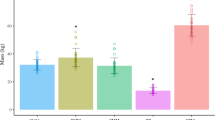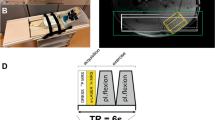Abstract
OBJECTIVE: To determine whether skeletal muscle energetics, measured by in vivo 31P-nuclear magnetic resonance spectroscopy during plantar flexion exercise, differ between multiethnic, prepubertal girls with or without a predisposition to obesity.
DESIGN: Cross-sectional study.
SUBJECTS: Girls (mean age and body fat±s.d.=8.6±0.3 y and 22.6±4.2%) were recruited according to parental leanness or obesity defined as follows: LN (n=22), two lean parents, LNOB (n=18), one lean and one obese parent; and OB (n=15), two obese parents.
MEASUREMENTS: A 3 min, rest–exercise–recovery plantar flexion protocol was completed. Work was calculated from the force data. Spectra were analyzed for inorganic intracellular phosphate (Pi), phosphocreatine (PCr), Pi/PCr (ratio of the low and high energy phosphates indicating the bioenergetic state of the cell), intracellular pH, and adenosine triphosphate (ATP). Magnetic resonance imaging was used to determine calf muscle volume.
RESULTS: BMI was lower in the girls in the LN group (15.9±1.5 kg/m2) compared to the OB group (16.7±1.3 kg/m2) of girls (P<0.05), with no difference with the LNOB group (16.7±1.9 kg/m2). Adjusted for muscle volume and cumulative work, no differences in Pi, PCr, Pi/PCr, pH, or ATP were observed among the LN, LNOB and OB groups at rest, the end of exercise, and after 60 and 300 s of recovery. From rest to the end of exercise, Pi and Pi/PCr (mean±s.d.: 0.2±0.1 vs 1.5±1.0) increased, whereas PCr and pH (7.04±0.06 vs 6.95±0.10) decreased (all P<0.001). By 60 s of recovery, Pi and Pi/PCr decreased, whereas PCr and pH increased (all P<0.001).
CONCLUSIONS: Skeletal muscle energetics, specifically Pi/PCr and pH measured during plantar flexion exercise, do not differ between prepubertal girls with or without a familial predisposition to obesity.
This is a preview of subscription content, access via your institution
Access options
Subscribe to this journal
Receive 12 print issues and online access
$259.00 per year
only $21.58 per issue
Buy this article
- Purchase on Springer Link
- Instant access to full article PDF
Prices may be subject to local taxes which are calculated during checkout



Similar content being viewed by others
References
Sapega AA, Sokolow DP, Graham TJ, Chance B . Phosphorous nuclear magnetic resonance: a non-invasive technique for the study of muscle bioenergetics during exercise Med Sci Sports Exerc 1987 19: 410–420.
Erkintalo M, Bendahan D, Mattei J, Fabreguettes C, Vague P, Cozzone PJ . Reduced metabolic efficiency of skeletal muscle energetics in hyperthyroid patients evidenced quantitatively by in vivo phosphorous-31 magnetic resonance spectroscopy Metabolism 1998 47: 769–776.
Kent-Braun JA, Miller RG, Weiner MW . Phases of metabolism during progressive exercise to fatigue in human skeletal muscle J Appl Physiol 1993 75: 573–580.
Kutsuzawa T, Shioya S, Kurita D, Haida M, Ohta Y, Yamabayashi J . 31P-NMR study of skeletal muscle metabolism in patients with chronic respiratory impairment Am Rev Respir Dis 1992 146: 1019–1024.
Maurer J, Konstanczak P, Sollner O, Ehrenstein T, Knollmann F, Wolff R, Vogl TJ, Felix R . Muscle metabolism of professional athletes using 31P-Spectroscopy Acta Radiologica 1999 40: 73–77.
Monsieurs K, Heytens L, Kloeck C, Martin J, Wuyts F, Bossaert L . Slower recovery of muscle phosphocreatine in malignant hyperthermia-susceptible individuals assessed by 31P-MR spectroscopy J Neurol 1997 244: 651–656.
Takahashi H, Inaki M, Fujimoto K, Katsuta S, Anno I, Niitsu M, Itai Y . Control of the rate of phosphocreatine resynthesis after exercise in trained and untrained human quadriceps muscles Eur J Appl Physiol 1995 71: 396–404.
Taylor DJ, Styles P, Mathews PM et al. Energetics of human muscle: exercise-induced ATP depeletion Magn Reson Med 1986 3: 44–54.
Thompson A, Damyanovich A, Madapallimattam A, Mikalus D, Allard J, Jeejeebhoy KN . 31P-nuclear magnetic resonance studies of bioenergetic changes in skeletal muscle in malnourished human adults Am J Clin Nutr 1998 67: 39–43.
Timmons JA, Gustafsson T, Sundber CJ, Jansson E, Hultman E, Kaijser L, Chwalbinska-Moneta J, Constantin-Teodosiu D, Macdonald IA, Greenhaff PL . Substrate availability limits human skeletal muscle oxidative ATP regeneration at the onset of ischemic exercise J Clin Invest 1996 97: 879–883.
Toussiant JF, Kwong KK, M'Kparu F, Weisskoff RM, LaRaia PJ, Kantor HL . Interrelationship of oxidative metabolism and local perfusion demonstrated by NMR in human skeletal muscle J Appl Physiol 1996 81: 2221–2228.
Kuno S, Takahashi H, Fujimoto K, Akima H, Miyamaru M, Nemoto I, Itai Y, Katsuta S . Muscle metabolism during exercise using phosphorous-31 nuclear magnetic resonance spectroscopy in adolescents Eur J Appl Physiol 1995 70: 301–304.
Taylor DJ, Kemp GJ, Thompson CH, Radda GK . Ageing: effects on oxidative function of skeletal muscle in vivo. Mol Cell Biochem 1997 174: 321–324.
Zanconato S, Buchthal S, Barstow TJ, Cooper DM . 31P-magnetic resonance spectroscopy of leg muscle metabolism during exercise in children and adults J Appl Physiol 1993 74: 2214–2218.
Lodi R, Montagna P, Soriani S, Iotti S, Arnaldi C, Cortelli P, Pierangeli G, Patuelli A, Zaniol P, Barbiroli B . Deficit of brain and skeletal muscle bioenergetics and low brain magnesium in juvenile migraine: an in vivo31P magnetic resonance spectroscopy interictal study Pediatr Res 1997 42: 866–871.
Kemp GJ, Taylor DJ, Barnes PRJ, Wilson J, Radda GK . Skeletal muscle mitochondrial dysfunction in alternating hemiplegia of childhood Ann Neurol 1995 38: 681–684.
Wade AJ, Marbut MM, Round JM . Muscle fiber type and aetiology of obesity Lancet 1990 335: 806–808.
Lillioja S, Young AA, Cutler CL, Ivy JL, Abbott WGH, Zawadski JK, Yki-Jarvinen H, Christin L, Secomb TW, Bogardus C . Skeletal muscle capillary density and fiber type are possible determinants of in vitro insulin insulin resistance in man J Clin Invest 1987 80: 415–424.
Kriketos AD, Pan DA, Lillioja S, Cooney GJ, Baur LA, Milner MR, Sutton JR, Jenkins AB, Bogardus C, Storlien LH . Interrelationships between muscle morphology, insulin action, and adiposity Am J Physiol 1996 270: R1332–R1339.
Kriketos AD, Baur LA, O'Connor J, Carey D, King S, Caterson ID, Storlien LH . Muscle fibre type composition in infant and adult populations and relationships with obesity Intl J Obes Relat Metab Disord 1997 21: 796–801.
Zurlo F, Larson K, Bogardus C, Ravussin E . Skeletal muscle metabolism is a major determinant of resting energy expenditure J Clin Invest 1990 86: 1423–1427.
Treuth MS, Hunter GR, Williams M . Effects of exercise intensity on 24-h energy expenditure and substrate oxidation Med Sci Sports Exerc 1996 28: 1138–1143.
Smith J, McNaughton L . The effects of intensity of exercise on excess post-exercise oxygen consumption and energy expenditure in moderately trained men and women Eur J Appl Physiol Occup Physiol 1993 67: 420–425.
Bahr R, Gronnerod O, Sejersted OM . Effect of supramaximal exercise on excess post-exercise oxygen consumption Med Sci Sports Exerc 1992 24: 66–71.
Bielinski R, Schutz Y, Jecquier E . Energy expenditure during the post-exercise recovery in man Am J Clin Nutr 1985 42: 69–82.
Maehlum S, Grandmontagne M, Newsholme E, Sjostrom OM . Magnitude and duration of excess post-exercise oxygen consumption in healthy young subjects Metabolism 1986 35: 425–429.
Treuth MS, Butte NF, Puyau M, Adolph A . Relations of parental obesity status to physical activity and fitness of prepubertal girls Pediatrics 2000 106: 1–8.
Treuth MS, Butte NF, Wong WW . Effects of familial predisposition to obesity on energy expenditure in multiethnic, prepubertal girls Am J Clin Nutr 2000 71: 893–900.
Taylor DJ, Bore PJ, Styles P, Gadian DG, Radda GK . Bioenergetics of intact human muscle; A 31P nuclear magnetic resonance study Mol Biol Med 1983 1: 77–94.
Quistorff B, Nielsen S, Thomsen C, Jensen KE, Henriksen O . A simple calf muscle ergometer for use in a standard whole-body MR scanner Magn Reson Med 1990 13: 444–449.
Gadian DG, Radda GK, Dawson MJ, Wilkie DR. In: Nuccitelli R, Deamer DW (eds) . Intracellular pH: its measurement, regulation and utilization in cellular functions Liss: New York 1982 61.
Allen PS, Matheson GO, Zhu G, Gheorgiu D, Dunlop RS, Falconer T, Stanley C, Hochachka PW . Simultaneous 31P MRS of the soleus and gastrocnemius in Sherpas during graded calf muscle exercise Am J Physiol 1997 273: R999–R1107.
Fowler MD, Ryschon TW, Wysong RE, Combs CA, Balaban RS . Normalized metabolic stress for 31P-MR spectroscopy studies of human skeletal muscle: MVC vs. muscle volume J Appl Physiol 1997 83: 875–883.
Okita K, Nishijima H, Yonezawa K, Ohtsubo M, Hanada A, Kohya T, Murakami T, Kitabatake A . Skeletal muscle metabolism in maximal bicycle and treadmill exercise distinguished by using in vivo metabolic freeze method and phosphorous-31 magnetic resonance spectroscopy in normal men Am J Cardiol 1998 81: 106–109.
Febbraio MA, Dancey J . Skeletal muscle energy metabolism during prolonged, fatiguing exercise J Appl Physiol 1999 87: 2341–2347.
Hargreaves M, McKenna MJ, Jenkins DG, Warmington SA, Li JL, Snow RJ, Febbraio MA . Muscle metabolites and performance during high-intensity, intermittent exercise J Appl Physiol 1998 84: 1687–1691.
Casey A, Constantin-Teodosiu D, Howell S, Hultman E, Greenhaff PL . Metabolic response of type I and II muscle fibers during repeated bouts of maximal exercise in humans Am J Physiol 1997 271: E38–E43.
Sahlin K, Soderlund K, Tonkonogi M, Hirakoba K . Phosphocreatine content in single fibers of human muscle after sustained exercise Am J Physiol 1997 273: C172–C178.
Trump ME, Heigenhauser GJF, Putman CT, Spriet LL . Importance of muscle phosphocreatine during intermittent maximal cycling J Appl Physiol 1996 80: 1574–1580.
Simoneau JA, Bouchard C . Genetic determinism of fiber type proportion in human skeletal muscle FASEB J 1995 9: 1091–1095.
Ravussin E, Lillioja S, Anderson TE, Christin L, Bogardus C . Determinants of 24-hour energy expenditure in man J Clin Invest 1986 78: 1568–1578.
Acknowledgements
We would like to thank the children who participated in the study and B Kertz for study coordination. This study was supported by NIH R29 HD34029 and USDA Agricultural Research Service Cooperative Agreement 6250-51000-023. The contents of this publication do not necessarily reflect the views or policies of the US Department of Agriculture, nor does mention of trade names, commercial products, or organizations imply endorsement by the US Government.
Author information
Authors and Affiliations
Corresponding author
Rights and permissions
About this article
Cite this article
Treuth, M., Butte, N. & Herrick, R. Skeletal muscle energetics assessed by 31P-NMR in prepubertal girls with a familial predisposition to obesity. Int J Obes 25, 1300–1308 (2001). https://doi.org/10.1038/sj.ijo.0801666
Received:
Revised:
Accepted:
Published:
Issue Date:
DOI: https://doi.org/10.1038/sj.ijo.0801666



